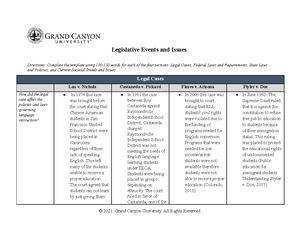- Information
- AI Chat
This is a Premium Document. Some documents on Studocu are Premium. Upgrade to Premium to unlock it.
Was this document helpful?
This is a Premium Document. Some documents on Studocu are Premium. Upgrade to Premium to unlock it.
Educational Terminology Associated with Lesson Planning
Course: Instructional Planning and Assessments for Elementary Teacher Candidates (ELM-210)
592 Documents
Students shared 592 documents in this course
University: Grand Canyon University
Was this document helpful?
This is a preview
Do you want full access? Go Premium and unlock all 8 pages
Access to all documents
Get Unlimited Downloads
Improve your grades
Already Premium?

Understanding Educational Terminology
Educational
Terminology
Brief Explanation Purpose in the Planning, Instruction and Assessment
Process
Lesson Plans
Lesson plans are step-by-step
instructions that stay within
standards and guidelines. These
lesson plans are created by the
teachers before class begins and
helps the student learn new
things.
“The purpose of lesson plans is to help students stay focused on
learning materials, provide timely feedback, allow students to
process time, and keep students motivated” (Estes & Mintz,
2016).
Classroom and Student
Factors/Grouping
“A classroom that has been
grouped when the one large
group of students assigned to
that classroom is divided into a
set of small groups for some
portion of the time they are in
the classroom”
Students have a better time learning when they are individually
addressed or when they are in groups. When the students are in
groups, they can learn to help each other and when working on
projects they can help provide feedback for each other.
© 2021. Grand Canyon University. All Rights Reserved.
Why is this page out of focus?
This is a Premium document. Become Premium to read the whole document.
Why is this page out of focus?
This is a Premium document. Become Premium to read the whole document.

